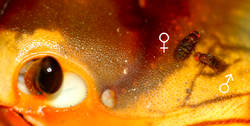Biology
D. endobranchia is closely associated with its crab host, with one to six flies found per infected crab. Adults hardly move at all, let alone fly, and are extremely reluctant to leave their fast-paced host. Courting and mating take place on the crab, and territories are defended between males. The eggs are placed around the crab's eyes. The hatched larvae migrate to the nephric pads and feed on microbes responsible for cleansing urine from nitrogenous compounds. From the second instar on, the larvae migrate to the gill chamber, where they stay up to several months. At the third instar they return to the mouth parts where they form a halo around the mouth opening. They later fall to the ground to pupate. [1]
At least three quarters of adult D. endobranchia found on land crabs were males. It is not clear whether this species has a skewed sex ratio, or whether females only visit crabs, or frequently switch host crabs. [1]
Host crabs are found using olfactory cues, but the substance or substances responsible for this are not known. [1]
This page is based on this
Wikipedia article Text is available under the
CC BY-SA 4.0 license; additional terms may apply.
Images, videos and audio are available under their respective licenses.
